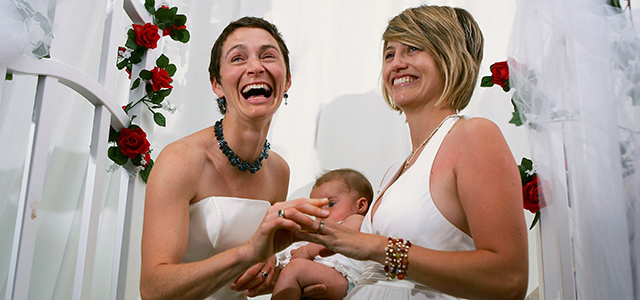
The U.S. Census Bureau said that it will count same-sex spouses as married couples for the first time, rather than grouping them with cohabiting partners. The agency said it would make the change with the September release of data from its largest household survey.
The new approach reflects the bureau’s evolving policy on reporting household relationships, as it tries to keep pace with social change. Same-sex marriage is now legal in 19 states and the District of Columbia, and only one state (North Dakota) has a ban that has not been challenged in court.
Previously, the Census Bureau categorized same-sex spouses as unmarried partners, even if they said they were married, and the bureau included the figures in published statistics about cohabiting couples.
Supporters of gay marriage describe the bureau’s changes as long overdue and say that recognition by the Census Bureau reflects Americans’ growing acceptance of same-sex relationships and legal recognition by courts in a growing number of states. In the long term, the impact will be to broaden and deepen the statistics available about the families, economic circumstances and other characteristics of same-sex married couples.
However, demographic data researchers are not sure how much of a real impact there will be from the data right away.
First, the same-sex married population is still very small. There were 56 million households headed by opposite-sex married couples reported in the 2012 American Community Survey. By contrast, only about 182,000 households headed by same-sex married couples were counted in a special tabulation by the bureau released separately from its published tables. (About 81,000 were male couples and 101,000 were female couples.)
Because of the large difference in the number of same-sex and opposite-sex spouses, the change in how they are counted should not affect overall marriage trends or characteristics, according to Census Bureau officials.
Second, the census’s data about married same-sex couples has flaws. The agency has acknowledged “a very serious problem” of overcounts of same-sex spouses, due to people in some heterosexual couples mistakenly checking the wrong sex box on the census questionnaire.
The Census Bureau currently produces its data on same-sex couples by using answers to questions about respondents’ sex and about how they are related to the householder, or person who fills out the census form. Agency officials are experimenting with alternative ways to ask relationship questions. They also are seeking information about dealing with this problem from other countries, such as Canada, New Zealand and the United Kingdom, that collect data about same-sex couples.
The census first included an option for “unmarried partner” for all couples in the 1990 census and the bureau reported counts from that census for both same-sex and opposite-sex cohabiters. However, the bureau had a policy not to count same-sex couples who said they were married as married couples until now. They changed respondents’ answers in different ways from decade to decade.
For example, if a same-sex couple reported being married in 1990, the bureau changed the sex of one of the spouses because gay marriage was not legal. Then, starting with the 2000 census, the agency changed how it categorized same-sex marriages again. In the 2000 census, if a same-sex couple reported they were married, the bureau changed their status to unmarried. Under its new policy, the bureau will count same-sex couples who say they are spouses as married couples.
The Census Bureau’s new policy “is an important step that shows how Census and U.S. society have changed in attitudes about the meanings of marriage and family,” Gary Gates, who studies the demographics of same-sex couples at the Williams Institute at UCLA Law School, said in an email. “Analytically, the impact of the change is relatively minimal because there are still data quality issues to be addressed and because the total number of married same-sex couples is not large enough to substantively alter broader statistics about married couples and families in the U.S.”
In recent years, the bureau has made data about same-sex spouses available on a limited basis. The special tabulation cannot be accessed through the agency’s official data portal, American FactFinder, and has only a restricted set of variables—for example, employment status is given but not occupation or industry. The agency plans to continue releasing these annual basic tables, according to Rose Kreider, chief of the bureau’s Fertility and Family Statistics Branch.
Detailed statistics about same-sex married couples (as well as opposite-sex married couples) will be accessible to expert users, via census microdata from both the 2013 American Community Survey and 2014 Current Population Survey this year. These are individual-level records scrubbed of identifying information that typically are released several months after the initial data. Microdata are available through the bureau website or the Minnesota Population Center’s Integrated Public-Use Microdata Series, and mainly are accessed using statistical software.



